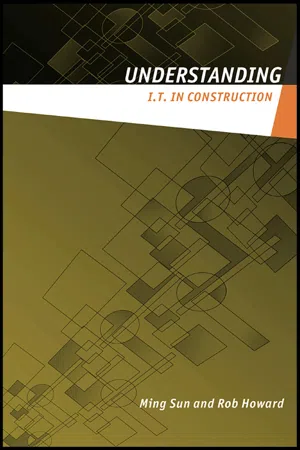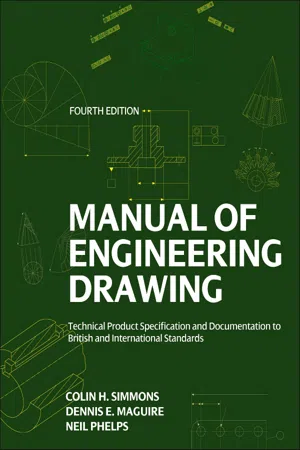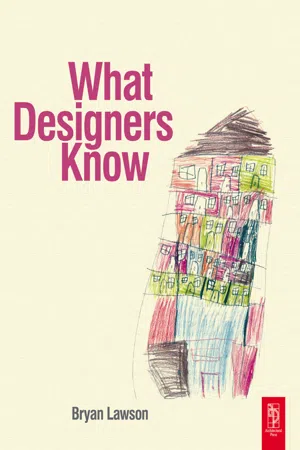Computer Aided Design
Computer Aided Design (CAD) refers to the use of computer software to create, modify, analyze, and optimize designs for various engineering and technical applications. CAD software allows designers and engineers to produce precise 2D and 3D models, enabling them to visualize and simulate their designs before they are physically created. This technology has revolutionized the design process, leading to increased efficiency and accuracy in product development.
8 Key excerpts on "Computer Aided Design"
- eBook - ePub
- Ming Sun, Rob Howard(Authors)
- 2004(Publication Date)
- Routledge(Publisher)
...People are motivated by the prospect of combining the creative and imaginative power of the designer with the analytical and computational power of the computer to make the architectural design process more informative and productive. As long ago as 1970s, Bazjanac (1975) identified three areas where computer applications were able to offer major benefits: Computer drafting systems could free designers from distracting and unproductive activities, allowing them to concentrate on the creative aspects of design. Computer analytical systems could support design decision making by enabling designers to test and evaluate design alternatives rapidly in the search for an optimum solution. Computer information management systems could offer designers instant access to accumulated knowledge in the building industry. This chapter will concentrate on CAD and visualisation systems. Figure 3.1 2D drawing (image courtesy of Autodesk) 3.1 Computer Aided Design AND DRAFTING Traditionally two dimensional (2D) drawings have been the main means of communication between members of the building team. Designers use a combination of 2D drawings and specification documents to communicate the design to engineers so that the engineers can make calculations. Similarly, the on-site building workers use drawings as instructions on where and how to lay the building foundation, how tall a wall should be built, how a wall and a roof are joined. For a typical building project, there are hundreds of drawings. The production of these drawing is a main task during the design stage. In 1970, architects were estimated to spend about 30% of their time on drawing. The basic function of CAD packages is that they allow a user to build up drawings by manipulating lines, circles, rectangles and texts interactively on the screen. Some architecture-specific CAD systems even provide graphical libraries of commonly used building elements - doors, windows and so on (Richens, 1990)...
- eBook - ePub
Manual of Engineering Drawing
British and International Standards
- Colin H. Simmons, Dennis E. Maguire, Neil Phelps(Authors)
- 2020(Publication Date)
- Butterworth-Heinemann(Publisher)
...Similarly by the purchase of a CAD system, a design does not emerge at the push of a button. The engineering designer is very much responsible for decisions taken at all technical stages between conception and production. The computer is an aid and performs as it is directed with rapidity and accuracy. The following notes are included to indicate areas of useful activity to assist the designer. Today it is all too common at the design conception stage for designers to go straight into modeling mode and before they know it, they have slipped into detail design mode and include far too much information in the concept design. Designers are encouraged to sketch and/or build simple models (Lego, plasticine, card) at the early stages, this is not a backward step and rewards can be gained from unshackling the designer from CAD at the start of a project. The preparation of two- and three-dimensional drawings and models and the projection of associated views is the ‘bread and butter’ work in the design office. Service manuals use exploded views so that people with no technical training can follow assembly sequences. Children stick together model kits with guidance using pictorial diagrams. CAD programs are available where a three-dimensional model can be produced automatically given two-dimensional views. From the dimensions of the component, the computer will calculate surface areas, volumes, weights for different materials, centers of gravity, moments of inertia, and radii of gyration; it can also use the applicable values for stress and other calculations, which are a necessary part of design. Computer models permit a study of special relationships and applications, which are given in the chapter which follows. Models can be manipulated into pleasing forms for artistic approval or for the basis for Additive Manufacturing or Rapid Machining before production work follows...
- eBook - ePub
- Mike Tooley(Author)
- 2010(Publication Date)
- Routledge(Publisher)
...What we are really talking about is the application of computers within engineering. Nowadays, the boundaries between the strict disciplines of CAD and CAM are becoming increasingly blurred and fully integrated CAE systems are becoming commonplace in engineering companies. We have already said that CAD is often used to produce engineering drawings. Several different types of drawing are used in engineering. An example of a CAD drawing is shown in Figure 7.1. FIGURE 7.1 Drop-down menus and extensive toolbars are available in this powerful CAD package which incorporates both 2D and 3D features 223 UNIT 10 Computer Aided Drawing Techniques Computer Aided Manufacture (CAM) Computer aided manufacture (CAM) encompasses a number of more specialised applications of computers in engineering including computer integrated manufacturing (CIM), manufacturing system modelling and simulation, systems integration, artificial intelligence applications in manufacturing control, CAD/CAM, robotics, and metrology. Computer aided engineering analysis can be conducted to investigate and predict mechanical, thermal and fatigue stress, fluid flow and heat transfer, and vibration/noise characteristics of design concepts to optimise final product performance. In addition, metal and plastic flow, solid modelling, and variation simulation analysis are performed to examine the feasibility of manufacturing a particular part. In a modern engineering company, all of the machine tools within a particular manufacturing company may be directly linked to the CAE network through the use of centrally located floor managers which monitor machining operations and provides sufficient memory for complete machining runs. Manufacturing industries rely heavily on computer controlled manufacturing systems. Some of the most advanced automated systems are employed by those industries that process petrol, gas, iron and steel. The manufacture of cars and trucks frequently involves computer-controlled robot devices...
- eBook - ePub
Manual of Engineering Drawing
Technical Product Specification and Documentation to British and International Standards
- Colin H. Simmons, Dennis E. Maguire(Authors)
- 2009(Publication Date)
- Butterworth-Heinemann(Publisher)
...Economic production requires that down time is eliminated before full-scale production commences. Computer aided draughting and design CAD is much more than drawing lines and geometry by electronic means. Similarly by the purchase of a CAD system, a design does not emerge at the push of a button. ‘Buy a computer and you do not need a draughtsman’ is also very different from reality (see Chapter 1). The engineering designer is very much responsible for decisions taken at all technical stages between conception and production. The computer is an aid and performs as it is directed with rapidity and accuracy. The following notes are included to indicate areas of useful activity to assist the draughtsman. The preparation of two- and three-dimensional drawings and models and the projection of associated views is the ’bread and butter’ work in the drawing office. Service manuals use exploded views so that people with no technical training can follow assembly sequences. Children stick together model kits with guidance using pictorial diagrams. CAD programs are available where a three-dimensional model can be produced automatically given two-dimensional views. From the dimensions of the component, the computer will calculate surface areas, volumes, weights for different materials, centres of gravity, moments of inertia, and radii of gyration; it can also use the applicable values for stress and other calculations, which are a necessary part of design. Computer models permit a study of special relationships and applications given in the chapter which follows. Models can be manipulated into pleasing forms for artistic approval or for the basis for Rapid Prototyping or Rapid Machining before production work follows. Previous techniques included modelling with plasticine and plaster, and applications ranged from ornaments to boat hulls and car bodies...
- eBook - ePub
Manual of Engineering Drawing
Technical Product Specification and Documentation to British and International Standards
- Colin H. Simmons, Dennis E. Maguire(Authors)
- 2012(Publication Date)
- Butterworth-Heinemann(Publisher)
...The computer is an aid and performs as it is directed with rapidity and accuracy. The following notes are included to indicate areas of useful activity to assist the draughtsman. The preparation of two- and three-dimensional drawings and models and the projection of associated views is the ‘bread and butter’ work in the drawing office. Service manuals use exploded views so that people with no technical training can follow assembly sequences. Children stick together model kits with guidance using pictorial diagrams. CAD programs are available where a three-dimensional model can be produced automatically given two-dimensional views. From the dimensions of the component, the computer will calculate surface areas, volumes, weights for different materials, centres of gravity, moments of inertia, and radii of gyration; it can also use the applicable values for stress and other calculations, which are a necessary part of design. Computer models permit a study of special relationships and applications, which are given in the chapter which follows. Models can be manipulated into pleasing forms for artistic approval or for the basis for Rapid Prototyping or Rapid Machining before production work follows. Previous techniques included modelling with plasticine and plaster, and applications ranged from ornaments to boat hulls and car bodies. CAD has revolutionized modelling capabilities. Sales departments utilize 3D illustrations in brochures and literature for promotional applications. Desktop publishing from within the company can very simply use illustrations generated as part of the manufacturing process. The scanning of photographs into a CAD system is also an asset especially as photographic work can be retouched, manipulated and animated. Multimedia applications with video and slide presentations form a large part of selling and advertising. Structural design requires a thorough knowledge of engineering material properties...
- eBook - ePub
- Sayed M. Metwalli(Author)
- 2021(Publication Date)
- Wiley(Publisher)
...4 Computer-Aided Design This chapter intends to present a brief synopsis of the computer-aided design field as mainly as geometric modeling. The coverage is geared toward the applications in machine design to develop a three-dimensional (3D) model. This necessitates the coverage of geometric modeling or 3D computer-aided drafting known as “CAD” rather than the traditional computer-aided design commonly known as “CAD.” The computer-aided drafting is related to computer graphics or geometric modeling. The real computer-aided design in machine element selection or adoption should be related to having the computer define proper geometry and material, and not only helping in 3D modeling or 3D drafting. CAD in the geometric modeling sense is just a c omputer- a ided d rafting (CAD) rather than computer-aided design (CAD). Since a great deal of geometric modeling – known as “CAD” – is employed in the design process, the coverage is focused on the 3D modeling as a necessary part in the design process; see Section 3.1. The understanding of the technology of producing a 3D geometric model is therefore of a profound effect in efficient production and utilization of available geometric modeling packages traditionally known as “CAD” tools. The use of computers to design synthesis of components is the objective of this textbook. The synthesis in terms of letting the computer aids in the definition of dimensions or geometry and material selection is what one should call a real computer-aided design or a computer-aided synthesis (CAS). This task is the purpose of the text. The 3D geometric modeling is essential in design presentation and product manufacturing. The 3D modeling is made easier, if the basics of the computer graphics are understood. This chapter intends to help in that regard. For further coverage, one can refer to texts in computer graphics such as Newman and Sproull (1979), Foley et al...
- eBook - ePub
- Alan Hayward, Frank Weare, A. C. Oakhill(Authors)
- 2011(Publication Date)
- Wiley-Blackwell(Publisher)
...Chapter 6 Computer Aided Detailing 6.1 Introduction Civil and structural engineers were one of the first groups to make use of computers. The ability to harness the computer's vast power of arithmetic made matrix methods of structural analysis a practical proposition. From this early beginning a whole range of computer programs and associated software has been developed to deal with most aspects of analysis and design. In the early days the use of the computer to produce drawings, while possible, did not receive much widespread attention. But now the use of computers for design and draughting can be said to have been the second industrial revolution. Computer draughting systems have been available as commercial products since the 1970s. Most of the early systems were developed by the electronics industry to meet its own needs in the production of printed and integrated circuits. To the civil and structural engineer these early systems seemed little more than electronic tracing machines and of no great practical use. However, they formed the basis for the subsequent developments of systems more suited to construction. The use of the computer to produce drawings differs in many ways from its use in analysis, design and other numeric activities, and computer draughting is substantially different from the traditional manual method. The essential item of equipment now used is known as the workstation. Add-on peripherals might comprise plotters, including three-dimensional (3-D) plotters allowing rapid prototyping (refer to section 6.6), and scanners. While the input to and output from a draughting system are in graphical form, the computer's own representation of a drawing is as a mathematical model. This is a very important point as it is the nature of this ‘model’ that dictates the ease or difficulty with which different draughting systems perform what, to the end user, is the same drawing task...
- eBook - ePub
- Bryan Lawson(Author)
- 2012(Publication Date)
- Routledge(Publisher)
...As Nigel Cross (2001) so succinctly puts it: ‘Why isn’t using a CAD system a more enjoyable, and perhaps, also a more intellectually demanding experience than it has turned out to be?’ Cross argues that using CAD may in some cases be quicker but is more stressful and that there is no evidence that the results are better. Could it be possible that this has to do with the way computers and human designers manipulate knowledge? If so some study of CAD, its achievements and deficiencies may tell us quite a bit about what designers know. The roles of the computer Computers can actually play several quite different roles in the design process and it is around these roles that we shall base the start of our exploration here. It is interesting that the earliest attempts to use computers in the design process were actually very much more ambitious than we would even contemplate today. Not surprisingly their success was very limited as we shall see for reasons we now understand. Perhaps the biggest disappointment in this field is the still rather limited success in getting computers actually to assist in the real business of design as opposed to performing relatively menial supporting tasks. The history of technology is one of the amplification of human capabilities. Mechanical devices have amplified our strength to lift and move objects including ourselves. Optical devices have amplified our ability to see either further as with the telescope or in more detail as with the microscope. Biotechnology has amplified our control over nature in order to feed or heal ourselves. Computing technology has amplified our cognitive abilities to store and recall information and to process it more speedily. This is certainly true for computer-aided drawing...







